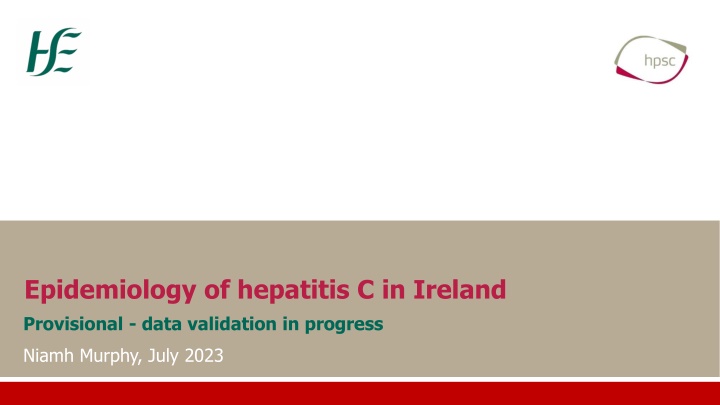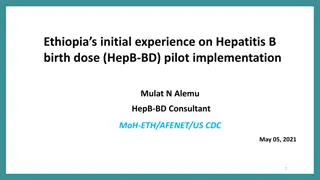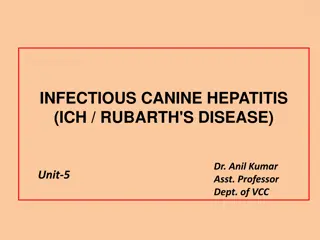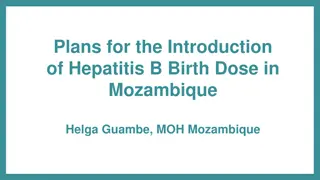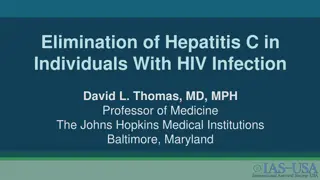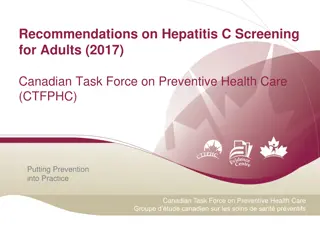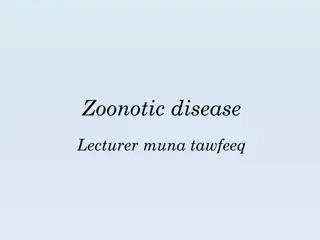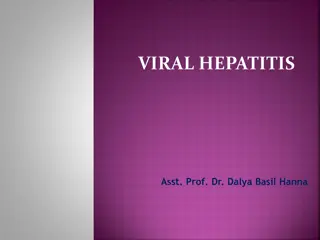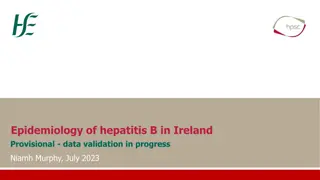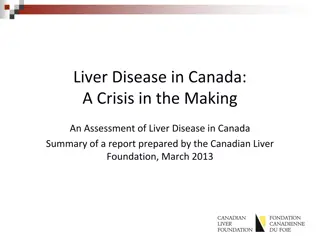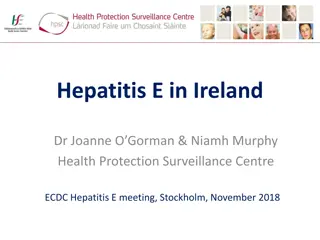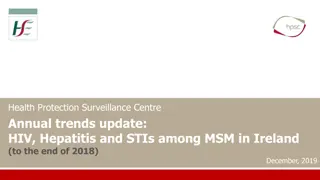Epidemiology of hepatitis C in Ireland
Hepatitis C, a viral infection affecting the liver, has notable implications in Ireland, with key transmission routes, clinical manifestations, and long-term consequences shaping its epidemiology. From transmission patterns to chronic infection risks, understanding the natural history and prevalence of Hepatitis C is crucial for effective management and intervention strategies.
Download Presentation

Please find below an Image/Link to download the presentation.
The content on the website is provided AS IS for your information and personal use only. It may not be sold, licensed, or shared on other websites without obtaining consent from the author.If you encounter any issues during the download, it is possible that the publisher has removed the file from their server.
You are allowed to download the files provided on this website for personal or commercial use, subject to the condition that they are used lawfully. All files are the property of their respective owners.
The content on the website is provided AS IS for your information and personal use only. It may not be sold, licensed, or shared on other websites without obtaining consent from the author.
E N D
Presentation Transcript
Epidemiology of hepatitis C in Ireland Provisional - data validation in progress Niamh Murphy, July 2023
Hepatitis C virus (1) Hepatitis C Virus first identified in 1989 Transmitted through exposure to blood from an infected person Routine screening of blood donations in Ireland started in 1991 Approximately 1,700 people were infected through contaminated blood/blood products prior to this Most newly diagnosed cases of hepatitis C in developed countries like Ireland are in people who inject drugs (PWID) and migrants from higher endemicity countries Hepatitis C can also be transmitted from an infected mother to her baby and sexually much less common, but risk higher in gay and bisexual men, and other men who have sex with men (gbMSM) and people living with HIV Most cases are initially asymptomatic or mildly symptomatic - acute infection is rarely detected & there can be a long lag time between infection and diagnosis Approx. 75% of those infected develop chronic infection
Hepatitis C virus (2) Chronic infection can cause liver inflammation, fibrosis, cirrhosis, liver cancer (hepatocellular carcinoma, HCC), liver failure and death 5-40% of chronically infected cases develop cirrhosis after 20-40 years of infection Of those with cirrhosis, 1.5-2.5% develop HCC annually Disease progression is faster in those who consume high levels of alcohol, males, people who were older at infection and those who are co-infected with HIV or hepatitis B Disease progression may also be influenced by metabolic (high BMI, diabetes) and host genetic factors Chronic infection can be successfully treated, >95% success rate with currently available direct acting antiviral drugs
Hepatitis C natural history Hepatitis C infection 6 months Acute infection followed by viral clearance (~25%) Hepatitis C RNA no longer detectable. Chronic infection (~75%) Hepatitis C RNA still detectable. Long-term hepatitis C infection 20 - 40 years At risk for Factors increasing rate of disease progression and disease severity High alcohol consumption High BMI, insulin resistance or Steatohepatitis Male gender Older age Co-infection with HIV Co-infection with hepatitis B Mild Liver fibrosis Moderate Advanced Cirrhosis of the liver (10-30% @ 40 yrs of infection) Factors decreasing or halting disease progression and disease severity Anti-viral treatment Liver transplant (temporary) Liver failure or hepatocellular carcinoma
Estimated worldwide prevalence of hepatitis C infection Source: https://www.thelancet.com/journals/langas/article/PIIS2468-1253%2821%2900472-6/fulltext
Epidemiology of hepatitis C in Ireland Hepatitis C became notifiable in 2004 2004-2022: 16,926 cases notified o highest number in 2007 (n=1,536) o Significant decrease since peak 480 cases notified in 2022 o Notifications include some (but not all) cases diagnosed before 2004, and some duplicates (full names not reported for all notifications) 2012: case definitions changed to explicitly exclude cases known to be resolved (not viraemic at time of diagnosis). Prior to 2012, approximately 25% of cases notified likely to have been past infections. 67% of cases notified 2004-2022 were male Age at notification has increased over time - fewer cases diagnosed in young adults, indicating incidence o Median age: 2004 31 years 2022 43 years o Mean age: 2004 33.3 years 2022 45.1 years Risk factor data collected 2007-2022 o data avail for 59% of cases o 67% were people who inject drugs (PWID) (current or past) o 11% were born in endemic countries or were asylum seekers (mode of transmission not reported) o 6% were reported as sexually acquired Most cases identified through screening in high risk settings, trends may not reflect incidence well
Number of notifications of hepatitis C in Ireland, 2004-2022 by sex and median age 1800 50 45 Number of notifications 1536 1600 1502 1398 Median age (years) 40 1400 1231 1231 1214 1208 35 1119 1200 30 1000 872 25 751 800 690 668 636 20 605 583 600 480 471 15 414 317 400 10 200 5 0 0 2004 2005 2006 2007 2008 2009 2010 2011 2012* 2013 2014 2015 2016 2017 2018 2019 2020 2021 2022 Male Female Unknown sex Median age males Median age females *Case definition changed in 2012 cases known to be resolved excluded from notification
Trends in sex-specific hepatitis C notification rates per 100,000 population in Ireland, 2004-2022 50 45 Notification rate per 100,000 population 40 35 30 25 20 15 10 5 0 2004 2005 2006 2007 2008 2009 2010 2011 2012 2013 2014 2015 2016 2017 2018 2019 2020 2021 2022 Male Female
Age and sex specific notification rates per 100,000 for hepatitis C in Ireland, 2022 (n=480) 35 30 Notification rates per 100,000 25 20 15 10 5 0 0-4 5-9 10-14 15-19 20-24 25-34 35-44 45-54 55-64 65+ Age group (years) Male Female
Trends in age-specific hepatitis C notification rates per 100,000 population in Ireland, 2004-2022 100 90 Notification rate per 100,000 population 80 70 60 50 40 30 20 10 0 2004 2005 2006 2007 2008 2009 2010 2011 2012 2013 2014 2015 2016 2017 2018 2019 2020 2021 2022 <30 years 30-39 years 40-49 years 50+ years
Number of notifications of hepatitis C by age group in Ireland, 2004-2022 1800 1537 1600 1502 Number of hepatitis C notifications 1398 1400 1231 1214 1208 1233 1119 1200 1000 872 751 800 690 669 636 607 583 600 480 473 420 326 400 200 0 2004 2005 2006 2007 2008 2009 2010 2011 2012 2013 2014 2015 2016 2017 2018 2019 2020 2021 2022 <30 years 30-39 years 40-49 years 50+ years Age unknown
% of hepatitis C notifications in each age group in Ireland, 2004-2022 100% 90% 80% % of hepatitis C notifications 70% 60% 50% 40% 30% 20% 10% 0% 2004 2005 2006 2007 2008 2009 2010 2011 2012 2013 2014 2015 2016 2017 2018 2019 2020 2021 2022 <30 years 30-39 years 40-49 years 50+ years
Hepatitis C notification rates per 100,000 population by HSE area in Ireland, 2004-2022 90 80 Notification rate per 100,000 70 60 50 40 30 20 10 0 2004 2005 2006 2007 2008 2009 2010 2011 2012 2013 2014 2015 2016 2017 2018 2019 2020 2021 2022 HSE E HSE M HSE MW HSE NE HSE NW HSE SE HSE S HSE W
Hepatitis C notification rates per 100,000 population by HSE area in Ireland, 2019-2022 20 18 Notification rate per 100,000 16 14 12 10 8 6 4 2 0 E M MW NE NW SE S W National HSE area 2019 2020 2021 2022
% of notifications of hepatitis C by most likely risk factor, where reported (n=7,755, 59%), Ireland, 2007-2022 No known risk factor, 4% Vertical transmission, 2% Tattooing/body piercing, 1% People who inject drugs, 67% Other, 6% Received blood or blood products, 3% Possible sexual exposure - unknown orientation, 1% Possible sexual exposure - MSM, 2% Possible sexual exposure - heterosexual, 3% Born in endemic country/asylum seeker, no risk factor reported, 11%
Trends in notifications of hepatitis C by most likely risk factor, in Ireland, 2007-2022 1800 1600 Number of notifications 1400 1200 1000 800 600 400 200 0 2007 2008 2009 2010 2011 2012 2013 2014 2015 2016 2017 2018 2019 2020 2021 2022 People who inject drugs Case notified through prison or homeless services Possible sexual exposure* Received blood or blood products Born in endemic country or asylum seeker Other Unknown
% of notifications of hepatitis C by most likely risk factor, where reported (data available n=7,755, 59%), Ireland, 2007-2022 100% 90% 80% % of notifications 70% 60% 50% 40% 30% 20% 10% 0% 2007 2008 2009 2010 2011 2012 2013 2014 2015 2016 2017 2018 2019 2020 2021 2022 People who inject drugs Received blood or blood products Possible sexual exposure Born in endmemic country/asylum seeker - risk factor not reported Case notified through prison or homeless services Other
% of notifications of hepatitis C by country/region of birth where reported (n=3,805, 29%), 2007-2022 Other, 1% North Africa and Middle East, 2% Latin America, 1% Ireland, 46% Sub-Saharan Africa, 2% Asia, 7% Western Europe, 7% Eastern Europe, 20% Central Europe, 14%
% of notifications of hepatitis C by country/region of birth where reported (n=194, 40%), 2022 Other, 1% Asia, 3% Ireland, 40% Sub-Saharan Africa, 4% Western Europe, 4% Latin America, 4% Eastern Europe, 35% Central Europe, 9%
Number of notifications of hepatitis C by region of birth where reported (n=3,805, 29%) in Ireland, 2007-2022 350 300 Number of notifications 250 200 150 100 50 0 2007 2008 2009 2010 2011 2012 2013 2014 2015 2016 2017 2018 2019 2020 2021 2022 Ireland Eastern Europe Central Europe Western Europe Asia Africa Latin America Other
Hepatitis C notifications in the first 6 months of 2023 252 cases of hepatitis C notified in the first half of 2023 - 18% increase compared to same period 2022 Age: 11% <30 years, 25% 30-39 years, 36% 40-49 years, 29% 50+ years Median age 43 years, mean age 44.7 years 71% of cases were male Some information on risk factor or proxy risk factor was reported for around half of cases o 45% people who inject drugs (current or former) o 7% tested in low threshold homeless or drug services, or in prison, mode transmission not reported o 30% born in an endemic country/asylum seeker, with mode of transmission not reported o 7% possible sexual exposure Country of birth/region of birth reported for 44% of cases, of which: o Ireland (46%), eastern Europe (35%), central Europe (9%), western Europe (3%), sub-Saharan Africa (2%), Latin America (2%), Other (3%)
Hepatitis C anti-viral treatment Highly effective direct acting antiviral (DAA) medicines for the treatment of hepatitis C have been available in Ireland since late 2014 These treatments eradicate the virus in over 95% of cases A HSE National Hepatitis C Treatment Programme was established in Ireland in 2016. This programme aims to provide treatment for all people living with hepatitis C in Ireland https://www.hse.ie/eng/national-hepatitis-c-treatment-programme/ https://www.hse.ie/eng/health/az/h/hepatitis-c/ National hepatitis C treatment programme data o DAAs >7,000 people treated o Pre-DAAs ~1,000 people treated Hepatitis C screening guidelines were developed in 2017 who to test https://www.gov.ie/en/collection/e4bb9d- hepatitis-c-screening/ Increasing case ascertainment o Hepatitis C home testing kits now available free of charge from the HSE o Increased use of point of care/rapid diagnostic tests Action plan for the health sector response to viral hepatitis in the WHO European Region With improved case ascertainment, referral and retention in care, hepatitis C could become a rare disease in Ireland within the next 5-10 years
Hepatitis C prevalence in Ireland Over 17,000 cases of hepatitis notified in Ireland between 2004 and April 2023 o Includes some duplicates (full names not always provided/name variations) o Includes some spontaneously resolved cases pre-2012 (potentially about 25% notifications 2004-2011 ~2,600 cases) o Includes cases that were chronically infected when notified but have since been successfully treated o A proportion of notified cases are also likely to have died 26% of cases of hepatitis C diagnosed in Scotland had died by end 2018 (https://hps.scot.nhs.uk/web-resources-container/surveillance-of-hepatitis-c-testing-diagnosis-and-treatment-in-scotland-2019-update/) Undiagnosed cases? o Routine testing in opioid substitution treatment settings, but small proportion of current or former PWID may not have engaged with drug treatment or other healthcare services o Migrants from higher endemicity countries significant number may not have been tested o St James s hospital emergency department BBV screening pilot study 2014-2015 - 5% anti-HCV positive, 13% were previously undiagnosed o Homeless Safetynet primary healthcare service 2015 study 40% of those tested were anti-HCV positive. Half were not aware of their positive status prior to testing. o Small number of people who received blood or blood products prior to donor blood screening may not have been tested HPSC/NVRL study: leftover sera 2014-2016 estimated viraemic HCV prevalence 0.57% (95% CI: 0.4-0.8) or 19,606 (95% CI: 13,758-27,860) Over 7,000 cases in Ireland treated with DAA drugs since late 2014 (National Hepatitis C Treatment Programme) Recent viraemic HCV estimates o 2018 Antenatal screening data: 0.19% viraemic infection - specimens from 2018 from Rotunda and National Maternity hospital o ECDC Modelling study general pop n: viraemic HCV 0.21% (95% CI: 0.13-0.35) or 7,844 individuals (95% CI: 4,711-13,035) o 2022 prevalence study 0.1% viraemic infection based on >11,000 anonymised residual sera from a nationwide selection of hospitals
Acknowledgements Area Departments of Public Health: SPHMs, SMOs, AMOs, Epidemiologists, Surveillance Officers, Surveillance Assistants, IPCNs, Administration staff Notifiers: Laboratory Directors and their staff, and Clinicians HCV treatment data: HSE National Hepatitis C Treatment Programme Blood donor screening data: Irish Blood Transfusion Service References available on request
